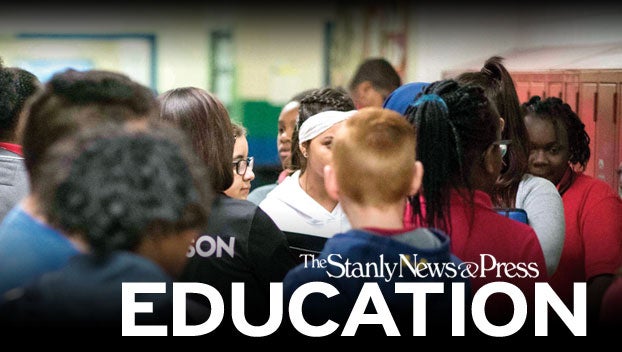Stanly school board stresses flexibility as roughly 800 students are set to return to schools in January
Published 2:11 pm Wednesday, December 2, 2020

- FROM METRO CREATIVE CONNECTION
|
Getting your Trinity Audio player ready...
|
The Stanly County Board of Education meeting Tuesday night may have featured many new faces, but the main discussion was an all-too familiar one for school districts across the country: how to handle in-person learning for the next semester in the event the COVID-19 pandemic worsens and new state restrictions are enacted.
Cases are continuing to increase across the state, including in Stanly, which recently surpassed 3,000 cumulative cases. According to the school system’s latest data, which runs from Nov. 19-Nov. 25, 18 students and four staff members were infected with the virus.
Dr. Amy Blake-Lewis, assistant superintendent of curriculum and instruction, spoke to the board about the second semester registration survey results detailing how many students are set to return to in-person instruction come January. The survey went out in November to families of remote students.
A similar “intent to return” survey was completed by families prior to the start of the school year, which showed that around 5,500 students signed up for in-person instruction, while around 2,150 signed up for remote instruction. Changes to learning preferences (shifting from remote to in-person or vice versa) cannot be made until the second semester.
According to the results of the latest survey, which were emailed to the Stanly News & Press, roughly 800 students who are currently working remotely have requested to come back for face-to-face instruction while around 1,350 have chosen to remain remote.
For elementary schools, 340 students are requesting to return to in-person instruction while 630 will continue to operate remotely. Central easily had the highest number of students wanting to return with 94, followed by Aquadale with 39. A total of 67 fifth-grade students and 63 first-grade students requested to return, the two grade levels with the highest numbers, while the lowest was kindergarten, with only 48 students wanting to come back. A total of 93 percent of remote elementary families responded.
For middle schools, 273 students are requesting to return while 387 will operate remotely. West Stanly led the way with 75 students wanting to return followed closely by Albemarle Middle with 74 students and North Stanly with 71. A total of 96 percent of remote middle school families responded.
For high schools, 180 students are requesting to return while 339 will operate remotely. West Stanly High had the highest number of students at 72, followed by North Stanly with 48 students and South Stanly with 33. A total of only 52 percent of high school families responded.
The school system’s curriculum and instruction team is working with personnel to make the necessary adjustments in teaching staff to account for the influx of students that are planning to return for in-person instruction. Blake-Lewis noted that as of now, the schools have enough space to be able to properly accommodate the students that will be coming back.
Board member Anthony Graves was concerned about the potential for a whiplash effect for students who would initially return to in-person learning just to abruptly return home if Gov. Roy Cooper were to issue an executive order limiting class sizes due to coronavirus cases increasing in the state.
Graves also expressed concern about the transmissibility of the virus in the school with more students returning next semester.
“We understand that the children can carry it (the virus) and they can potentially expose staff to it and that’s a major concern,” he said, noting that it would cause teachers to quarantine at home and miss instructional time.
He wanted the board to agree to not abide by any future restrictions Cooper might make to reimpose class size restrictions and send students back home.
“I’m not going to be put in a position where we’re going to have these families make the decision about bringing their kids back in only to be told, ‘Oops, they’re going to have to go back home,’ ” he said.
Blake-Lewis told the board that the school system could not go against any of Cooper’s orders and they instead would need to revisit their own plans and make appropriate adjustments. She added that the school system has extended the color-coded calendar for middle and high school students, which details specific A and B days, through the end of the school year.
Graves mentioned that any future decisions made by the school system would come with great forethought and would not be made in a hasty or arbitrary fashion.
“I don’t want there to be a shock or surprise…if we have to make a change,” he said.
Board member Glenda Gibson emphasized that other school districts are operating under similar conditions and that flexibility going forward would be key.
“We’re just going to have to be as flexible as we possibly can…we’re doing everything that we can to bring those families that want their children back in for face-to-face,” she said.
Superintendent Dr. Jarrod Dennis mentioned that, due to any upcoming changes that might have to be enacted if the pandemic worsens, there is a possibility that students will have different teachers for the second semester.
The Tuesday meeting was the first for several newly elected members. Carla Poplin, Bill Sorenson and Rufus Lefler were sworn in for the first time. Melvin Poole, Ryan McIntyre and Patty Crump are no longer serving as their terms expired this month.
Jeff Chance was selected to serve as the new chairman while Glenda Gibson was chosen to serve as the vice chairwoman.
While he paid homage to the previous board members, Graves was excited about the new makeup of the board.
“What’s exciting to me is the new board members that are coming in are fighters and I would say that’s what we need,” he said.
The next board meeting will be 7 p.m. Jan. 5.





